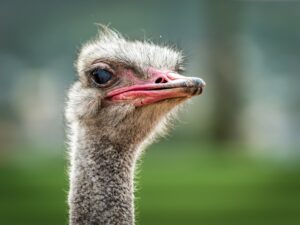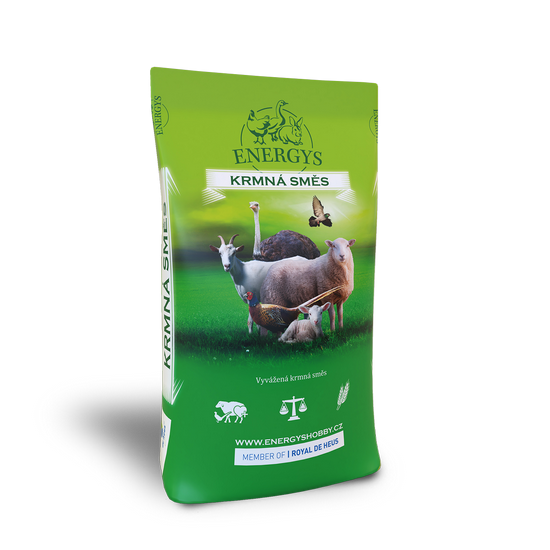Rabbits
Poultry
Laying hens
Quails
Guinea pigs
Pigs
Ostriches
Sheep and goats
Pigeons
Pheasants
Forest animals
Breeding and Fattening Ostriches
Just twenty five years ago no one would have believed that there would be ostrich farms in this country. Which species of large flightless bird are suitable for farming and what should you feed them?
Farming these largest birds spread from the African continent, where the first ostrich farms with domesticated birds were established, to other continents, including the USA and Europe. It can be assumed that these African domesticated flightless birds can expect a different fate to that befalling the now extinct flightless giants from Madagascar a few centuries ago.
Characteristic traits of large flightless birds (ratites)
The Common ostrich is a member of the ratite (flightless) group of birds, along with the South American rheas (2 species) and Australian-Asian species such as the cassowaries (3 species), emus (1 species) and kiwis (5 species). The ratites are a group of flightless birds, which use their strong, muscular legs as their principal mode of movement. However, this does not apply to the South American tinamous order, which is included in the aforementioned flightless birds according to the new system of classification. Ratites have a number of common physical traits, such as a paleognathous palate, a specifically shaped pelvis, uneven feathering, a reproductive organ (penis) and a nesting method during which the male typically cares for the eggs and young.
Suitable feed for ostriches
 Ostriches are not strict vegetarians, they also eat insects, small mammals, lizards and occasionally also bird eggs in the wild. They prefer the leaves of dicot plants, as well as seeds and berries when foraging for plant matter. Under farm conditions, adult ostriches are most often fed a complete pelleted feed, supplemented by fresh green fodder, vegetables, apples, and root crops.
Ostriches are not strict vegetarians, they also eat insects, small mammals, lizards and occasionally also bird eggs in the wild. They prefer the leaves of dicot plants, as well as seeds and berries when foraging for plant matter. Under farm conditions, adult ostriches are most often fed a complete pelleted feed, supplemented by fresh green fodder, vegetables, apples, and root crops.
Feed for chicks and young birds should contain a greater amount of protein Mineral supplements, particularly calcium and phosphor, are important not only for skeletal growth but also for eggshell formation during the breeding season.
Ostriches swallow small stones and sand to help crush and grind their food. If the birds do not have access to this material, they must be provided with grit. Water requirements, which the birds should always have a fresh supply of, are based on climatic conditions and also from the feed the birds are given.
Ratites kept on commercial and hobby farms
Common ostrich
The Common ostrich, which reaches weights of up to 150 kg when adult, is the most interesting member of the African flightless birds from the economic aspect. This largest of birds, which can live for up to 70 years, has excellent eyesight and hearing to make up for its handicap of being flightless. And it also makes up for this handicap by running, when it is able to reach speeds of over 50 km per hour over short distances.
The typical black and white colour of the males, with their decorative wing feathers, is in sharp contrast to the brown-grey colour of the females. The calves, head and neck are either bare or covered in down. The young birds gain their adult colour at the end of their second year, but their sex is apparent when they reach 9 months of age. While the females reach sexual maturity at two to three years, the males take a year longer to mature. Ostrich chicks grow quite quickly, they weigh up to 50 kg at six months of age and double this weight by the time they reach a year old.
Greater rhea
The Greater rhea, which is at home on the steppes and savannas of eastern South America, is another farmed species of flightless bird, which weighs much less than the ostrich however (up to 30 kg). The brownish-grey female is lighter than the male, which has a black neck. The chicks are striped. This species has practically the same care and feed requirements as its African cousin. There is even a wild rhea population in Europe, specifically in the Schaalsee biosphere reservation, which is populated by birds who escaped from a farm in Schleswig-Holstein. The North German population of rhea numbered 566 individuals in 2018, of which over half were the previous year’s chicks.
Emu
And finally, the last flightless adept for farming is the biggest Australian bird – the emu, which reaches weights of up to 50 kg. Like the previous two species this bird, with its silky brownish feathering and blue skin on its bare neck, has adapted well to our climatic conditions. And is just as undemanding in regard to care and feed.
Related posts
6. April 2022
The farming of the double-fingered ostrich for the production of feathers, skin meat and eggs began in the mid-19th century in africa. Commercial breeding of the largest flightless bird on the planet began in the 1990s.
21. August 2019
The African ostrich was domesticated during the second half of the previous century in South Africa. Domesticated ostriches have been reared on Czech farms for their meat, leather and feathers since 1993. How egg laying and hatching take place? And what are the most frequent issues affecting ostriches?
15. August 2019
Just twenty five years ago no one would have believed that there would be ostrich farms in this country. Which species of large flightless bird are suitable for farming and what should you feed them?
Related products

OSTRICH REPRO
A supplementary feed for ostriches in the laying period. Add an additional 20% of dry fodder or up to 50% of green fodder. Thanks to a high content of chosen substances it supports fertility and higher hatching.

OSTRICH MAXI
A supplementary feeding mix for weaning and fattening ostriches from 6 months to achieval of sexual adulthood or slaughter. Supports fast growth, high meat content and excellent taste. Add a high quality bulky protein feed to the mix.

OSTRICH MINI
A complete feed for the starting phase of weaning and fattening ostriches. Use it from hatching to 6 months of age. After the period given it is advantageous to continue with fattening with the Ostrich MAXI mix. It does not contain coccidosistats.

OSTRICH UNI
A supplementary feeding mix for ostrich breeds in the non hatching period. Cereals and bulky feeds are added to the mix. This feed totally covers the need for vitamins and minerals.
